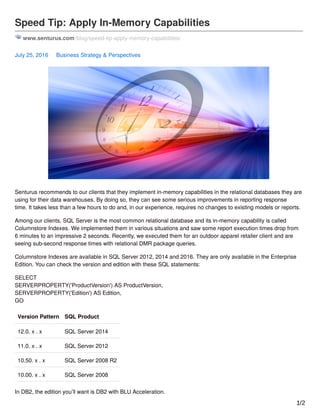Speed Tip Apply In-Memory Capabilities
- 1. Speed Tip: Apply In-Memory Capabilities www.senturus.com/blog/speed-tip-apply-memory-capabilities/ July 25, 2016 Business Strategy & Perspectives Senturus recommends to our clients that they implement in-memory capabilities in the relational databases they are using for their data warehouses. By doing so, they can see some serious improvements in reporting response time. It takes less than a few hours to do and, in our experience, requires no changes to existing models or reports. Among our clients, SQL Server is the most common relational database and its in-memory capability is called Columnstore Indexes. We implemented them in various situations and saw some report execution times drop from 6 minutes to an impressive 2 seconds. Recently, we executed them for an outdoor apparel retailer client and are seeing sub-second response times with relational DMR package queries. Columnstore Indexes are available in SQL Server 2012, 2014 and 2016. They are only available in the Enterprise Edition. You can check the version and edition with these SQL statements: SELECT SERVERPROPERTY('ProductVersion') AS ProductVersion, SERVERPROPERTY('Edition') AS Edition, GO Version Pattern SQL Product 12.0. x . x SQL Server 2014 11.0. x . x SQL Server 2012 10.50. x . x SQL Server 2008 R2 10.00. x . x SQL Server 2008 In DB2, the edition youŌĆÖll want is DB2 with BLU Acceleration. 1/2
- 2. In Oracle itŌĆÖs an Enterprise Edition option called (surprisingly) Oracle Database In-Memory. Happy Speeding! To learn more on the subject, check out our webinar: Demystifying In-Memory Technologies. Stay on top of business intelligence topics, read other Senturus blogs at: http://www.senturus.com/blog/. Data Prep / In-Memory Technology 2/2


